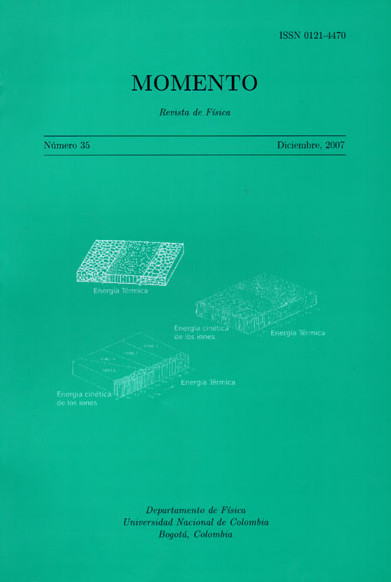Simulación numérica de reacciones químicas catalizadas.
Keywords:
Oxidación del CO, Simulación Monte Carlo, Catálisis. (es)CO oxidation, Monte Carlo simulation, Catalysis. (en)
Downloads
Utilizando el método de simulación Monte Carlo se estudió la cinética de la reacción 2CO + O2 -> 2CO2 sobre nanopartículas de Pt(110). Estas partículas exhiben superficies con estructuras (1 × 2) y (1 × 1) que corresponden a las fases α y β, respectivamente. En la simulación se considera que la reacción sigue el mecanismo de Langmuir- Hinshelwood. La velocidad de producción del CO2 depende de la presión parcial de CO, PCO y exhibe dos puntos criticos ξ1 y ξ2 en los cuales se presentan transiciones de fase de primer y segundo orden. Estos dos puntos definen una zona reactiva. Por fuera de este intervalo la producción de CO2 es nula debido a que la superficie del catalizador se encuentra saturada por la adsorción de oxígeno (PCO < ξ1) y de monóxido de carbono (PCO > ξ2). En estado estacionario y en cualquier punto del intervalo (ξ1,ξ2) la superficie del catalizador está parcialmente cubierta con partículas de CO y O. En este caso, los adsorbatos se organizan de manera natural sobre la superficie sin seguir un criterio de regularidad evidente y obedecen un principio de autosemejanza, responsable de la formación de estructuras fractales. En este trabajo se determina, usando el método de conteo por cajas la dimensión fractal D de la distribución de adsorbatos en la zona reactiva como función de PCO. Además, se muestra el efecto de considerar en el modelo de la reacción, los procesos de difusión y desorción del CO.
The kinetics of the 2CO + O2 -> 2CO2 reaction on Pt(100) nanoparticles was studied using the Monte Carlo simulation method. These particles present surfaces with (1×2) and (1×1) structures, which correspond to α and β phases, respectively. The reaction is considered as following a Langmuir-Hinshelwood type mechanism. The CO2 production rate depends on the CO partial pressure and shows two critical points ξ1 and ξ2 in which first and second order kinetic transitions occur. These points define a reactive zone. Outside this interval the CO2 production is zero because the catalyser’s surface is saturated by the adsorption of O (PCO < ξ1) and CO (PCO > ξ2). In steady state and on any point in the (ξ1,ξ2) interval the surface of the catalyser is partially covered with CO and O particles. In this case, the adsorbates organize themselves in a natural way on the surface without following an evident regularity criterion, and obeying a self-similarity principle, responsible for the fractal structures formation. In this work the fractal dimension D of adsorbate distributions in the reactive zone was determined as a function of the CO partial pressure. The fractal dimension was calculed using the box counting method. It is also shown the effect of both, CO diffusion and desorption on the fractal dimension.
How to Cite
APA
ACM
ACS
ABNT
Chicago
Harvard
IEEE
MLA
Turabian
Vancouver
Download Citation
Article abstract page views
Downloads
License
Those authors who have publications with this journal, accept the following terms:
a. The authors will retain their copyright and will guarantee the publication of the first publication of their work, which will be subject to the Attribution-SinDerivar 4.0 International Creative Commons Attribution License that permits redistribution, commercial or non-commercial, As long as the Work circulates intact and unchanged, where it indicates its author and its first publication in this magazine.
b. Authors are encouraged to disseminate their work through the Internet (eg in institutional telematic files or on their website) before and during the sending process, which can produce interesting exchanges and increase appointments of the published work.



















